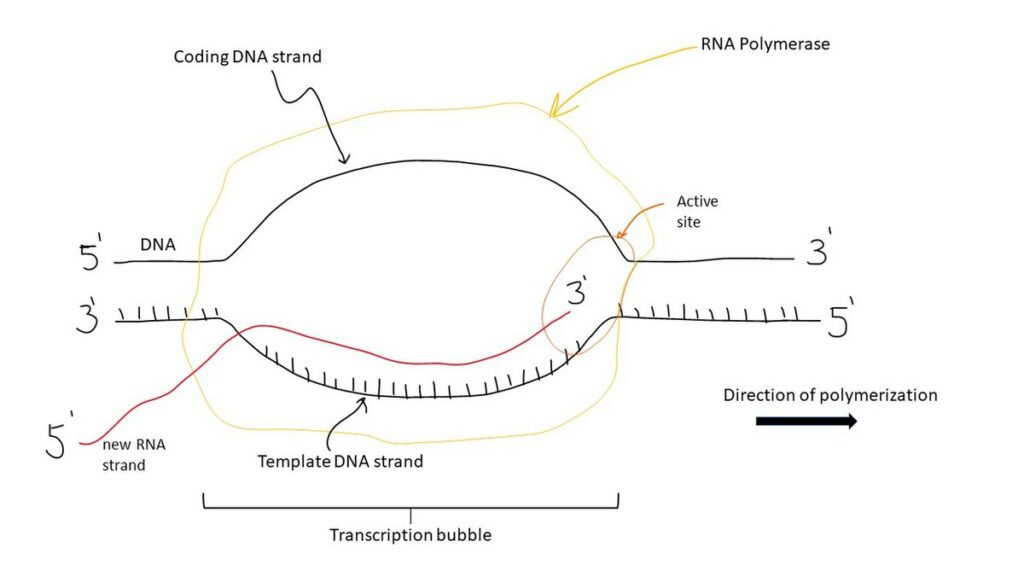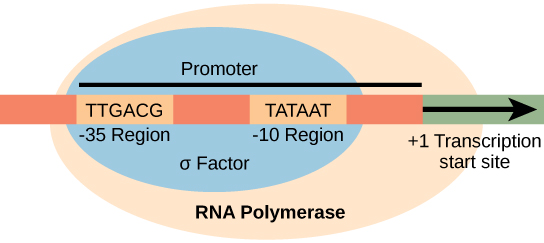Main Body
Prokaryotic Transcription- Initiation
Prokaryotic Transcription
Dr.V.Malathi
The process of transcription occurs in the nucleus of the cell in eukaryotes and the mRNA transcript must be transported to the cytoplasm for protein synthesis . In prokaryotes, which lack membrane-bound nuclei and other organelles, transcription occurs in the cytoplasm of the cell. Therefore, the processes of transcription and translation, can all occur simultaneously. This is referred to as . The intracellular level of a bacterial protein can quickly be amplified by multiple transcription and translation events occurring concurrently on the same DNA template. Prokaryotic transcription often covers more than one gene and produces polycistronic mRNAs that specify more than one protein.
Prokaryotic RNA Polymerase
- The process of transcription begins when an enzyme called RNA Polymerase which attaches to the template DNA strand and begins to catalyze production of complementary RNA. Prokaryotes use the same RNA polymerase to transcribe all of their genes.
- In E. coli, the polymerase is composed of five polypeptide subunits, comprising the Core enzyme and the holoenzyme .
- The five subunits include
- two α-subunits : are necessary to assemble the polymerase on the DNA
- β-subunit : binds to the ribonucleoside triphosphate that will become part of the nascent “recently born” mRNA molecule;
- β′ – subunit : binds the DNA template strand.
- subunit σ : is involved only in transcription initiation. It confers transcriptional specificity such that the polymerase begins to synthesize mRNA from an appropriate initiation site. Without σ, the core enzyme would transcribe from random sites
The α, α, β, and β′ comprise the polymerase core enzyme. The polymerase comprised of all five subunits is called the (a holoenzyme is a biochemically active and is comprised of an enzyme and its coenzyme).
The Process of Prokaryotic Transcription
Template or Non coding strand
DNA is double-stranded, but only one strand serves as a template for transcription at any given time. This is called the noncoding strand.
Non template or Coding strand
The other strand of DNA which is not serving as template is called the or coding strand . This strand is referred to as the coding strand because its sequence will be the same as that of the new RNA molecule. In most organisms, the strand of DNA that serves as the template for one gene may be the nontemplate strand for other genes within the same chromosome.
Upstream and Down stream Sequences
These are conventions used to describe features of a DNA sequence, gene or mRNA related to the position and direction (5′ to 3′) of transcription by RNA polymerase or translation by the ribosome.
Downstream (or 3′ to) is in the direction of transcription (or translation) whereas
Upstream (5′ to) is in the direction from which the polymerase (or ribosome) has come.( Upstream DNA sequences are before the start site of transcription)

Image “Transcription Bubble” by Ristinn via Wikimedia Commons is licensed under CC BY-SA 4.0
INITIATION
The first step in transcription is initiation, when the RNA pol binds to the DNA upstream (5′) of the gene at a specialized sequence called a promoter .
Prokaryotic Promoters
- The DNA sequence onto which the proteins and enzymes involved in transcription bind to initiate the process is called a. Promoters usually exist upstream of the genes they regulate. The specific sequence of a promoter determines whether the corresponding gene is transcribed all of the time, some of the time, or hardly at all. The structure and function of a prokaryotic promoter is relatively simple
- The -10 consensus sequence or the Pribnow box : In prokaryotes, most genes have a sequence called the Pribnow box, with the consensus sequence TATAAT positioned about ten base pairs away from the site . This serves as the location of transcription initiation. Not all Pribnow boxes have this exact nucleotide sequence; these nucleotides are simply the most common ones found at each site.
- The -35 consensus sequence : Many genes also have the consensus sequence TTGCCA at -35 position, upstream of the start site
- Upstream element : an A-T rich region 40 to 60 nucleotides upstream that enhances the rate of transcription

“Prokaryotic Promoter” Image from Biology 2e (2nd edition), an OpenStax resource licensed under CC BY 4.0
The process of transcription starts with the binding of the RNA pol “holoenzyme” binding to the template DNA and unwinds the DNA double helix in order to facilitate access to the gene. The sigma subunit conveys promoter specificity to RNA polymerase; that is, it instructs the RNA polymerase where to bind. There are a number of different sigma subunits that bind to different promoters. These sigma subunits assist in turning genes on and off as conditions change.
The mRNA product is complementary to the template strand and is almost identical to the other DNA strand, called the non-template strand, with the exception that RNA contains a uracil (U) in place of the thymine (T) found in DNA. Like DNA polymerase, RNA polymerase adds new nucleotides onto the 3′-OH group of the previous nucleotide. This means that the growing mRNA strand is being synthesized in the 5′ to 3′ direction.
The process of Transcription and Translation occuring simultaneously.
Active enzyme comprising of an enzyme and its coenzyme
Also called non coding strand . It is the DNA strand which acts as template for transcription
Otherwise called as non coding strand .. This DNA strand does not serve as template for transcription
The DNA sequence on to which the proteins and enzymes involved in transcription bind .to initiate the process of transcription

